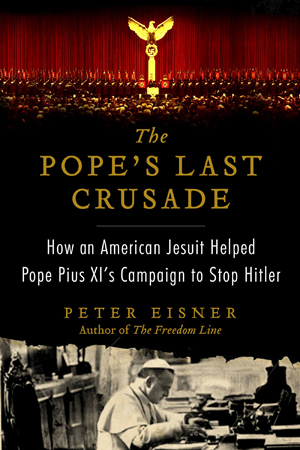
DAVID ADAMS reads Peter Eisner’s account of how American priest John LaFarge supported Pope Pius XI’s little known efforts to counter the rise of anti-Semitism in the days before the outbreak of World War II…
Peter Eisner
The Pope’s Last Crusade
William Morrow/Harper Collins, New York, 2013
ISBN-13: 978-0062049155

“In The Pope’s Last Crusade, Peter Eisner shows how Pope Pius XI, who died in February, 1939, spent the last few years and months of his life fighting against the rising tide of anti-Semitism being seen in Europe and, in particular, how, in the months before his death, he had commissioned an American Jesuit priest, John LaFarge, to write an encyclical on the issue.”
There’s been much written about the role of the Vatican and that of Pope Pius XII during World War II including criticism over its policy of neutrality in the face of the Holocaust and praise for the humanitarian role it played in helping thousands of Allied soldiers and Jews escape.
But what has escaped much attention is the role of the previous pope, Pius XI, in raising his voice to counter fascist racism in the lead-up to the war. In The Pope’s Last Crusade, journalist and editor Peter Eisner shows how Pope Pius XI, who died in February, 1939, spent the last few years and months of his life fighting against the rising tide of anti-Semitism being seen in Europe and, in particular, how, in the months before his death, he had commissioned an American Jesuit priest, John LaFarge, to write an encyclical on the issue.
LaFarge, editor of the influential Jesuit publication, America magazine, had prior experience – in 1936 he had written what was an influential book, Interracial Justice, on the issue of racism, calling on churches to lead the fight against it. It was this book which had apparently caught the Pope’s eye and which, when LaFarge visited Europe over several months in 1938 ostensibly to report on what was happening there, led him to summon LaFarge to a private audience and asked him to prepare on encyclical on the linked issue of anti-Semitism.
Eisner writes that LaFarge, who would later receive numerous awards for his life spent fighting for human rights in the US, spent a couple of months preparing the encyclical – with the help of others, notably his key supporter German Jesuit Gustav Gundlach – and while he had intended to present the finished document to the Pope himself, ill-health and concerns about his family back in the US, meant he left Europe in something of a rush and left it to others to ensure the encyclical reached the Pope. It was a decision, says Eisner, which he would regret “for the rest of his life”.
In the end, whether it did or not is a matter of some speculation but Eisner is at pains to point out that there were those inside the Vatican who did not want it published – notably the then Superior General of the Jesuit Order, Wlodimir Ledóchowski – and did what they could to ensure it never happened, at least partly because of a belief that communism posed the bigger threat than fascism. In any event, Pope Pius XI, who had been in ill-health for some time, died before it was released and his successor (and former Vatican Secretary-of-State), Pope Pius XII, decided not to do so. The Pope’s death also meant a meeting that he had scheduled with Italian bishops – in which he had told a group of student leaders that he wanted to make “one last statement” and challenge Hitler and Mussolini – never went it ahead.
Eisner, whose book has raised controversy in some quarters, runs through some of the suspicions raised by the timing of the Pope’s death but, as he points out, Pope Pius XI’s state of health in the weeks before his death “was so precarious that he could have at any time”.
He ends by quoting the editors of the National Catholic Reporter who published a report on the encyclical against anti-Semitism after it was found among LaFarge’s papers after his death in 1963 in which they concluded that – considering that when the encyclical was written Hitler had only “begun to move into full-scale persecution of the Jews” as well as, among other factors, the “moral weight” the papacy carried – the publication of the document at the time “may have saved hundreds of thousands, perhaps millions of lives”.
“That can never be known,” Eisner writes. “It was only clear that Pope Pius XI took a stance in favor of absolute morality and defended to his last breath his principles of decency and humanity, nothing more, nothing less.”





